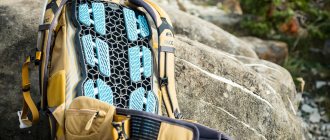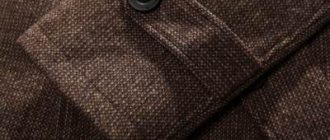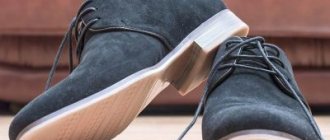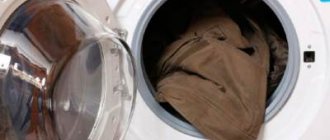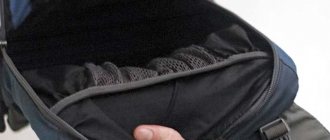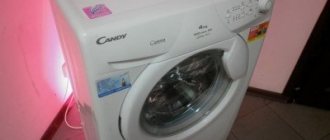A school backpack is an essential attribute of most students. Daily use by a child cannot but affect the appearance of the bag.
Even expensive and very high-quality backpack models need to be washed over time. There are rules by following which you can refresh its appearance and extend its service life.
Is it possible and how to wash a school backpack (frame, with an orthopedic back, etc.) in an automatic washing machine and by hand? Details are in the article.
Is it possible or not?
There should be a label on the inside of the backpack indicating whether the backpack can be washed and what types of processing of the product are allowed.
Depending on the model, the following types of cleaning are possible:
- manual;
- in the washing machine;
- dry;
- dry cleaning
The latter option involves completely eliminating self-processing and transferring washing to professionals.
Dry cleaning is often used as an intermediate step before the main wash . But for some types of backpacks, it is the only way to put things in order.
To maintain a school backpack in hygienic condition, it is recommended to wash it once every 3 months.
Is it possible to wash the backpack?
Manufacturers most often do not recommend doing this. Most models have a special waterproof impregnation, which gradually washes out when washed. The guaranteed protection of the contents of the backpack from rain and snow is lost, the fabric changes its appearance and becomes less dense. To answer the question about washing, you need to study the product label, which indicates the care parameters. It is located inside the backpack, most often in the largest compartment near one of the side seams. If it states that washing is allowed, go ahead. Just follow the temperature regime and other recommendations. If washing is prohibited, to maintain the appearance of your expensive exclusive or customized travel backpack, it is better to use dry cleaning services.
The product label indicates the care parameters recommended by the manufacturer.
How often to wash
There are two extreme options: not to do it at all or, conversely, very often. In the first case, the backpack accumulates dirt, which becomes more and more difficult to remove over time, and in the second, it wears out faster: the fabric wears out, the dye is washed out, and sometimes deformation occurs. Ultimately, the product loses its attractive appearance in a short period of time. Therefore, you need to wash a backpack as it gets dirty: a school backpack, a city backpack, and any backpack that is used daily - once every 2-3 months, a tourist backpack - 1-2 times a year.
Preparing for washing
Preparing to process a child's backpack begins with completely emptying it of its contents. After this, you need to shake it out, turning it upside down with the locks open.
If possible, clean the inside with a vacuum cleaner. It would be a good idea to inspect your backpack for damage.
If they exist, they must be eliminated in advance:
- fix zippers;
- trim hanging threads;
- sew up torn areas.
For dusty backpacks, the top layer of dirt can be removed by walking along the outside with a damp sponge.
Pronounced stains from food, grass, ink, etc. deserve special attention. They must be processed before the main wash cycle. This can be done with a stain remover that does not contain chlorine.
The product is applied with a brush with soft bristles and rubbed gently. If the stains are small, an old toothbrush will help to rub them out.
All removable elements, including keychains, must be removed before washing . They are cleaned separately.
If the backpack is then sent into the drum of the washing machine, the zippers of the compartments should be fastened. For hand washing, on the contrary, it is advisable to unfasten them.
Proper drying
The backpack is dried in a well-ventilated area or outside. It is prohibited to use hair dryers or heating devices for drying.
If there is a risk that the backpack will change its shape when hanging, then while drying it is better to place it on a stool, which is placed in the bathroom. It is recommended to open all compartments, zippers, and pockets so that air can penetrate inside and the briefcase dries faster, but this should not be done immediately, but after most of the moisture has gone. This will avoid distortion of the zippers and the entire structure.
Manually
Hand washing a child's school bag is less common than washing it in a machine. If there are difficult stains on the outside or inside, they are treated with a stain remover.
After half an hour, proceed to the main processing:
- Warm water is drawn into a large basin or directly into the bathtub.
- Dilute the detergent.
- Dipping a backpack into the water.
- Using a sponge, clean the briefcase from the outside and inside. It is necessary to act methodically, treating zone by zone.
- After finishing cleaning, you need to rinse the bag on both sides with non-hot water to completely remove any remaining detergent.
- Dry.
In the washing machine
Washing in a washing machine is a very convenient option that allows you to quickly and effectively remove dirt from your backpack and refresh the appearance of the item.
Such processing must be carried out in compliance with all rules:
Prepare the bag for washing. Make sure all zippers are closed.- Pour the prepared detergent into the washing powder compartment.
- Set the “delicate wash” mode.
- Make sure that the water heating temperature is no more than +40ºС.
- For backpacks of complex shape, with seals on the back, it is advisable to exclude spinning.
- Start the wash.
- At the end of the wash cycle, remove the backpack from the drum.
- Wipe the inside and outside of the product. This will allow the bag to dry faster and prevent mold from forming.
- Dry.
Washing in a special mesh will help prevent damage to the backpack and drum.
Important Tips
To avoid damaging the product during washing, you must follow the following rules for caring for it:
The product must be washed closed. This applies to zippers, rivets, Velcro and other fasteners.- If the bag is being washed for the first time, then the selected detergent should be tested on an inconspicuous area of the fabric, tracking its reaction.
- For washing, it is recommended to choose the simplest detergents with a minimum content of dyes, fragrances and other aggressive components.
- White backpacks can be soaked in bleach. It is not used for dark and black fabrics.
You need to start removing stains as early as possible. Old stains are more difficult to deal with.
You will find maximum useful information about washing clothes and various fabric products here.
Dry cleaning
Dry cleaning will help tidy up a backpack that cannot be washed in water. The following products fall into this category:
- made of natural or artificial leather;
- vinyl;
- containing special impregnations;
- having non-removable elements that are prohibited from getting wet.
For bags that cannot be immersed in water, cleaning can be done with a soft brush and a mild soap solution. If the material is leather, then it may be enough to refresh the surface with a damp cloth.
A good assistant in cleaning a backpack made of suede, leather or textiles are cleaning foams, which can be purchased in specialized departments of household chemicals.
Among them worthy of attention:
- Silver;
- Liqui Moly;
- Saphir;
- Salton;
- Twist and others.
The main requirement is to avoid excessive moisture in the material.
Features for different types of products
Some branded backpacks require special washing conditions. There are also rules for processing products with USB and an orthopedic back. There are certain features of caring for leather and suede backpacks.
Beckman
Manufacturers of Beckmann backpacks do not recommend machine washing. However, most users load models into the machine, since it will be difficult to manually get rid of dirt.
Basic recommendations:
Remove the hard metal insert from the product.
The plastic elements are non-removable, so they are left inside. Be sure to unscrew the light bulb with batteries; they are attached with double-sided tape, so they can be easily removed. There is no point in twisting a raincoat and Velcro decorations in the machine, so they are unfastened before washing.- Set the machine to a “gentle” or “delicate” wash program with a temperature setting of 30 degrees. The spin is turned off.
- To prevent the backpack from hitting the walls of the drum, a terry towel is loaded with it. You can protect the print with a mesh laundry bag or an old pillowcase.
- A gel or liquid concentrate is used as a detergent.
- After the cycle is completed, the product is dried under natural conditions.
Minor stains can be dealt with manually by applying a soap solution. After 15 minutes, remove the stain with a clean damp cloth.
With USB cable
If the backpack is equipped with a USB port or headphones, then you can wash it only after disconnecting them. Most often, such devices are removable, so there are no problems with caring for the product.
A bag with a USB cable is washed in the same way as other similar products . The type of fabric and the manufacturer's general recommendations must be taken into account. The method of cleaning will depend on this: manual, machine or dry.
If the USB is not removable, then getting such backpacks wet is strictly prohibited. Contact with water will damage the device.
Swissgear
Branded Swiss backpacks Swissgear are washed both manually and automatically.
The exception is products equipped with a rigid, non-removable frame and impregnated with a water-repellent composition. They are not loaded into the washing machine drum.
To remove dirt from them, use a soap solution in which a sponge is moistened and the stains are carefully removed. You can also vacuum the product to rid it of dust.
If machine wash is selected, use only liquid detergents. The water temperature should not exceed 30 degrees. The spin is turned off.
After washing, the product is not wrung out or twisted , leaving it to dry naturally.
Leather
A leather backpack is protected from prolonged contact with water and machine washable. It is not allowed to be machine washed. To care for the accessory, only dry or wet cleaning is suitable.
If the lining is dirty, wash it with soapy water and a brush, turning the fabric outward. Do not allow liquid to come into contact with the skin or stitches. Glued, non-stitched surfaces are especially carefully protected.
Use a damp soft cloth to remove dust from the skin. To combat stubborn stains, use a weak alcohol solution or soapy water.
Learn more about washing leather backpacks here.
Kanken
The original Kanken backpack is sewn from a unique fabric - vinylon, so it cannot be washed in a machine. This will lead to damage to the product, the appearance of creases and discolored spots.
Bags from this company require careful care . Kanken backpacks are processed by hand, avoiding excess friction.
Gentle formulations containing a minimal amount of chemical components are used as detergents, for example, “Eared Nanny” dish gel.
If there is heavy contamination, soak the product in a weak soap solution for 15 minutes. Then the backpack is rinsed under running cool water.
Even more information about processing backpacks of this type is here.
School
Information on the rules for caring for a school backpack is presented on the product label . If the manufacturer allows machine washing, then it should be done according to general recommendations. The hard back is removed from the product and all items are removed.
The machine wash mode should be “delicate”, with a water temperature no higher than 30 degrees. Preference is given to liquid detergents.
To remove single stains, you can process the school bag manually. Use a soap solution and a brush, or a professional stain remover. Be sure to take into account the type of fabric and color of the product.
More information about washing a school backpack can be found here.
Suede
The suede backpack is washed only by hand. Contact with water should be minimal. If possible, the product is dry cleaned using a special brush.
Washing rules:
- prepare a soap solution, it should be cool;
- Apply the cleaning agent to the backpack using a sponge;
- leave for 5 minutes;
- remove with a clean damp cloth;
- dry the product in natural conditions.
Do not scrub a suede backpack with a hard-bristled brush or treat it with aggressive detergents. Caring for it should be as gentle as possible.
With orthopedic back
The orthopedic backrest is removed from the backpack before washing. If it is not removable, then you should not load such a product into the washing machine.
You need to pay attention to the material from which the rigid frame is made:
- The metal back is removed or machine washable.
- The plastic inserts can be left on, but the product must be washed in a bag using a counterweight. To do this, load a terry towel or sheet into the drum.
- Foam orthopedic backrests tolerate both hand and machine washing.
- Cardboard backs do not tolerate contact with water, so such backpacks are subjected to either dry or surface wet cleaning.
Pinpoint stains are removed using specialized means, for example, ammonia or hydrogen peroxide.
How does the material affect the process?
School bags can be made from various materials and have a complex design . For example, a compacted back, a large number of small parts. Most models are made from several types of materials, the features of which must be taken into account when choosing a washing method:
- Leather, suede, vinyl .
School backpacks made of vinyl, artificial or natural leather, as well as suede ones are prohibited from being washed. Their cleaning should be as gentle as possible - without significant moisture and intense exposure. - Denim . This type of bag should be washed separately from other items, as denim fades easily. The spin cycle in the washing machine should be set to minimum.
- Synthetics. Synthetic material is used very often for school bags and backpacks. In most cases, such fabric tolerates washing well.
Features of processing frame backpacks with an orthopedic back
Many backpack models, especially those designed for younger schoolchildren, have special seals on the back. These may include plastic and metal plates. The complex design is designed to ensure that the backpack maintains its shape.
If all these elements are removable, then they are removed before washing in the machine. Otherwise, the backpack cannot be placed in the drum.
Frame seals require careful handling. For them, spinning and twisting should be excluded.
The video will show you how to wash a frame backpack:
Proper drying
After washing by any method, the briefcase needs to be dried. The best choice is to do it in natural conditions.
Procedure:
- After washing, turn the bag over so that the remaining water pours out from the inside;
- Use a moisture-absorbing cloth to blot the outside and inside;
- turn the product upside down and use clothespins or straps to secure the bag in this position on the rope.
During the drying process, the pockets should remain open to allow faster drying.
If you need to dry the bag faster, you can fill it with crumpled paper that absorbs moisture . You need to do the same with pockets. As the paper gets wet, it is recommended to replace it with a new one.
The drying process must be carried out thoroughly. A poorly dried item can not only acquire an unpleasant odor, but also become a source of mold.
Removing unpleasant odor
During use or after washing the school backpack, an unpleasant odor may remain on it. It's usually hard to deal with. You can hang the product in fresh air. If this does not help, you should use more advanced methods:
- Vinegar – add a couple of tablespoons of 9% vinegar to the water. It neutralizes unpleasant odors. The briefcase needs to be soaked in the solution for half an hour.
- A bag of salt is placed inside the backpack and closed for a couple of hours.
- Activated carbon - tablets must be crushed in a mortar, and then sprinkled with coal on areas that smell bad.
After washing, it is better to hang the backpack in fresh air. This way, the sharp and persistent odors of household chemicals will disappear faster.
